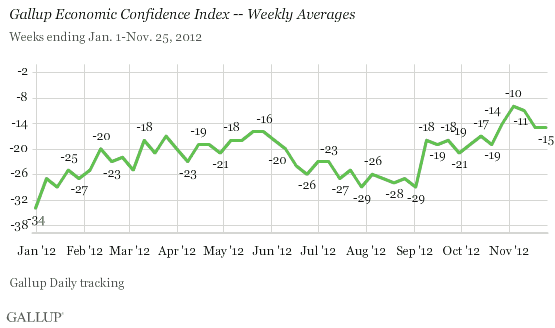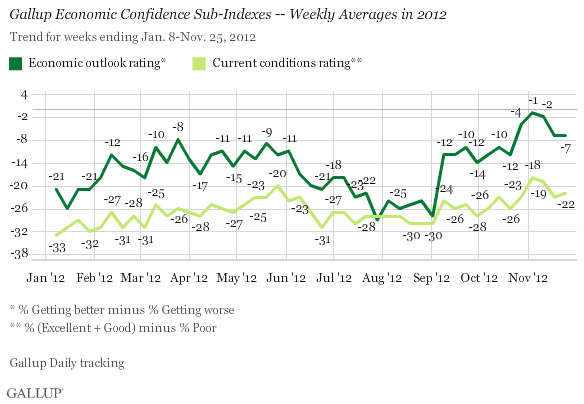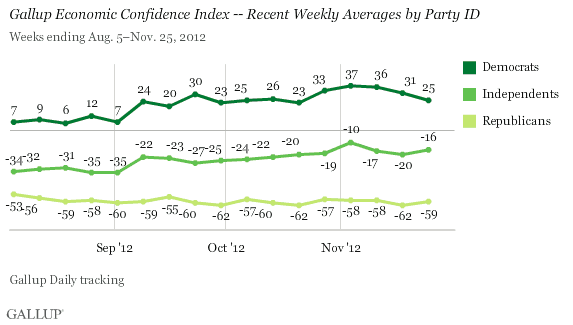WASHINGTON, D.C. -- Gallup's U.S. Economic Confidence Index was -15 for the week ending Nov. 25, unchanged from the week prior. Americans remain less confident than they were just before the election, but still more confident than they were throughout much of the year.

Both components of the index -- Americans' ratings of the current economy and their perceptions of the direction of the economy -- were essentially flat last week. Seventeen percent of Americans say the economy is excellent or good, while 39% say it is poor, resulting in a -22 current conditions rating, compared with -23 the week prior. A plurality of Americans continue to be pessimistic about the future of the economy, with 43% saying it is getting better and 50% saying it is getting worse, resulting in an economic outlook rating of -7, unchanged from the week prior.

The steady picture at the national level masks slight shifts among partisan groups. Economic confidence declined six points last week among Democrats, to 25 from 31, but improved among Republicans (to -59 from -62) and independents (to -16 from -20).
This marks the first improvement in confidence among Republicans since the week of the presidential election, although it is a modest increase and their views remain still highly negative. Democrats, on the other hand, are increasingly pessimistic. The week before the election, economic confidence among Democrats was at 37, the highest seen since the start of Gallup Daily tracking in 2008, but has since dropped 12 points. Still, Democrats remain net positive and near the most positive they have been this year.

Bottom Line
The lack of change in U.S. economic confidence last week may indicate a leveling off following the presidential election. Opinions of the economy became increasingly polarized by political party leading up to and immediately following the election. Now that the election is over and pressing economic issues are at hand, such as the fiscal cliff and expiring unemployment benefits, Americans may be less inclined to view the economy through a politically charged lens. Whether this hypothesis bears out will be seen in the weeks to come as Congress confronts the fiscal cliff and reaches a solution that will likely require bipartisan compromise.
Gallup.com reports results from these indexes in daily, weekly, and monthly averages and in Gallup.com stories. Complete trend data are always available to view and export in the following charts:
Daily: Employment, Economic Confidence, Job Creation, Consumer Spending
Weekly: Employment, Economic Confidence, Job Creation, Consumer Spending
Read more about Gallup's economic measures.
View our economic release schedule.
Survey Methods
Results are based on telephone interviews conducted as part of the Gallup Daily tracking survey Nov. 19-25, 2012, with a random sample of 2,910 adults, aged 18 and older, living in all 50 U.S. states and the District of Columbia, selected using random-digit-dial sampling.
For results based on the total sample of [national adults/registered voters], one can say with 95% confidence that the maximum margin of sampling error is ±1 percentage point.
Interviews are conducted with respondents on landline telephones and cellular phones, with interviews conducted in Spanish for respondents who are primarily Spanish-speaking. Each sample includes a minimum quota of 400 cellphone respondents and 600 landline respondents per 1,000 national adults, with additional minimum quotas among landline respondents by region. Landline telephone numbers are chosen at random among listed telephone numbers. Cellphone numbers are selected using random-digit-dial methods. Landline respondents are chosen at random within each household on the basis of which member had the most recent birthday.
Samples are weighted by gender, age, race, Hispanic ethnicity, education, region, adults in the household, and phone status (cellphone only/landline only/both, cellphone mostly, and having an unlisted landline number). Demographic weighting targets are based on the March 2011 Current Population Survey figures for the aged 18 and older non-institutionalized population living in U.S. telephone households. All reported margins of sampling error include the computed design effects for weighting and sample design.
In addition to sampling error, question wording and practical difficulties in conducting surveys can introduce error or bias into the findings of public opinion polls.
For more details on Gallup's polling methodology, visit https://www.gallup.com/.
